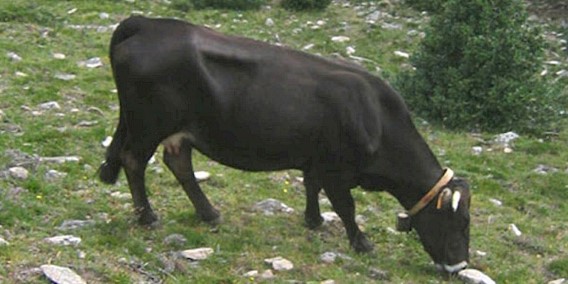Albera are an endangered breed of small cattle indigenous to
the Albera Massif, which divides Catalonia from France and lies partly in the comarca of Alt Empordà in the Catalan province of Girona, and partly in the comarca of Vallespir in the French département of Pyrénées-Orientales.
Although the presence of a cattle breed in the Albera Massif
was noted in the nineteenth century, the first description of the Albera dates from 1957. At that time three sub-types were distinguished within the breed: a dark-coated type; a variable paler type; and a third type deriving from cross-breeding with Braunvieh stock. More recently, the types are considered to be tw the Negra, or dark type, and the Fagina, or paler type. In 1999 the Fagina type was found to be genetically closer to the Bruna de los Pirineos breed than to the Albera Negra type.
A breeders' association, the Associació de Ramaders de la
Vaca de l'Albera, was founded in 2008. The Albera breed received official recognition
on 27 July 2011; a breed standard was approved, and a herd book established. At
the end of 2014 the total population was recorded as 763, of which 618 were
female and 145 male.
Albera are highly resistant to cold, though susceptible to
heat, and are well adapted to the steep terrain of the Albera Massif. They are
kept year-round in semi-feral conditions, at an altitude between 200 and 1000
meters, foraging for food including the shoots and mast of the beech trees of
the massif. They have little contact with man, and little productive capacity:
cows calve every two years, and produce barely enough milk for the calf; meat
yield is very low, of the order of 35–40%. The cattle are used in vegetation
management: by clearing undergrowth they help to prevent forest fires.
Albera are highly resistant to cold, though susceptible to
heat, and are well adapted to the steep terrain of the Albera Massif. They are
kept year-round in semi-feral conditions, at an altitude between 200 and 1000 meters,
foraging for food including the shoots and mast of the beech trees of the
massif. They have little contact with man, and little productive capacity: cows
calve every two years, and produce barely enough milk for the calf; meat yield
is very low, of the order of 35–40%. The cattle are used in vegetation
management: by clearing undergrowth they help to prevent forest fires.
